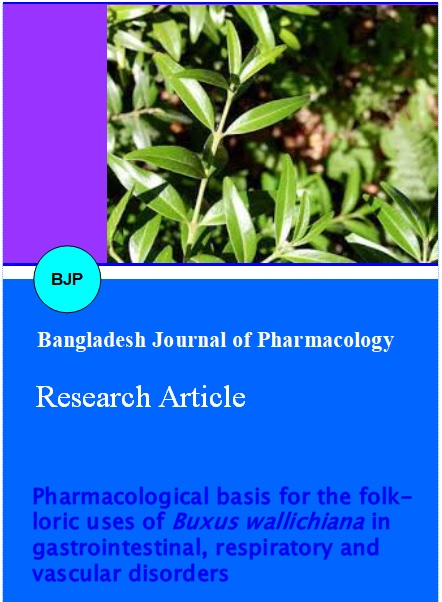Pharmacological basis for the folkloric uses of Buxus wallichiana in gastrointestinal, respiratory and vascular disorders
DOI:
https://doi.org/10.3329/bjp.v10i2.22285Keywords:
Anticholinergic, Bronchodilator, Ca2 -channel blockade, Spasmogenic, VasodilatorAbstract
In vitro study was carried out to explore the pharmacological basis of crude extract of Buxus wallichiana for its folkloric uses in gastrointestinal, respiratory and vascular disorders. In jejunum preparations, crude extract (0.03 ± 1.0 mg/mL) caused a transient spasmogenic effect followed by the spasmolytic effect at higher doses (3.010 mg/mL). In atropinized jejunum preparation, crude extract inhibited the spontaneous and K+ (80 mM)-induced contraction, suggesting that spasmolytic effect is mediated through the Ca+2-channel blockade. The Ca+2-channel blockade effect was confirmed when pretreatment of tissue with extract produced a dose-dependent shift in Ca+2 concentration-response curves to the right, similarly as verapamil. Furthermore, crude extract exhibited non-specific relaxant effect on carbachol- (1 µM) and K+ (80 mM)-induced tracheal contractions, suggesting the coexistence of anticholinergic and Ca+2-antagonistic properties. Moreover, it relaxed the K+ (80 mM)- and phenylephrine (1 µM)-induced contraction in rabbit aorta, suggesting the Ca+2-channel blockade. These findings may validate the folkloric uses of B. wallichiana in constipation, bronchitis, asthma and hypertension.
Downloads
899
509 Read
251

Published
How to Cite
Issue
Section
License
Authors who publish with this journal agree to the following terms:
- Authors retain copyright and grant the journal right of first publication with the work simultaneously licensed under a Creative Commons Attribution License that allows others to share the work with an acknowledgement of the work's authorship and initial publication in this journal.
- Authors are able to enter into separate, additional contractual arrangements for the non-exclusive distribution of the journal's published version of the work (e.g., post it to an institutional repository or publish it in a book), with an acknowledgement of its initial publication in this journal.
- Authors are permitted and encouraged to post their work online (e.g., in institutional repositories or on their website) prior to and during the submission process, as it can lead to productive exchanges, as well as earlier and greater citation of published work (See The Effect of Open Access).
